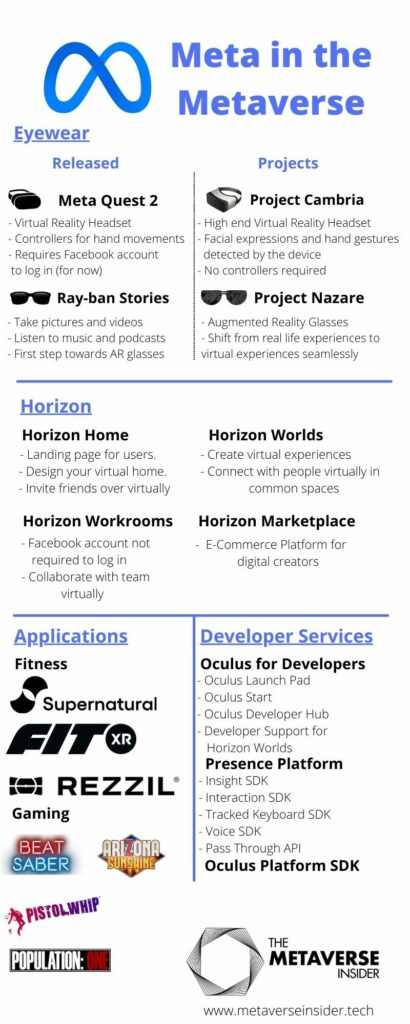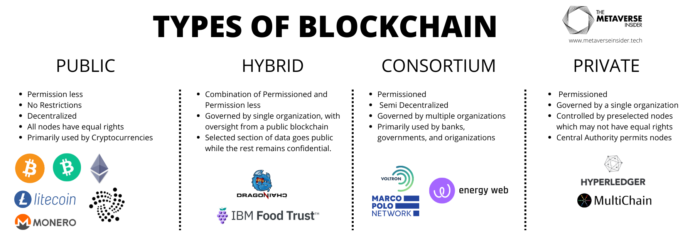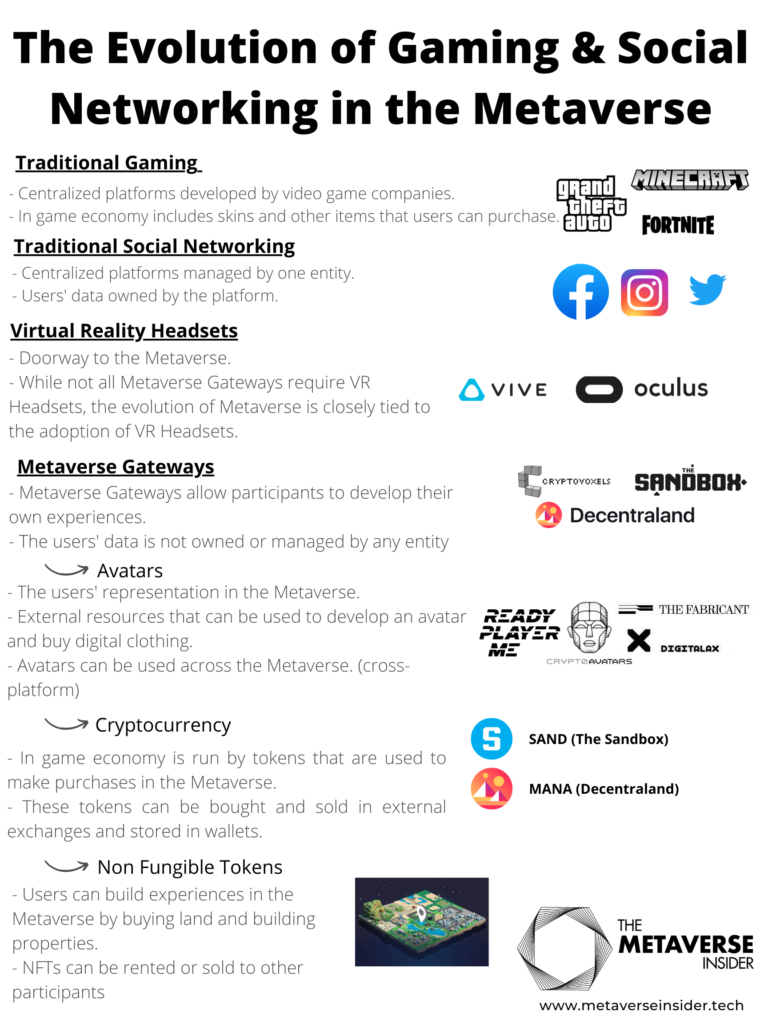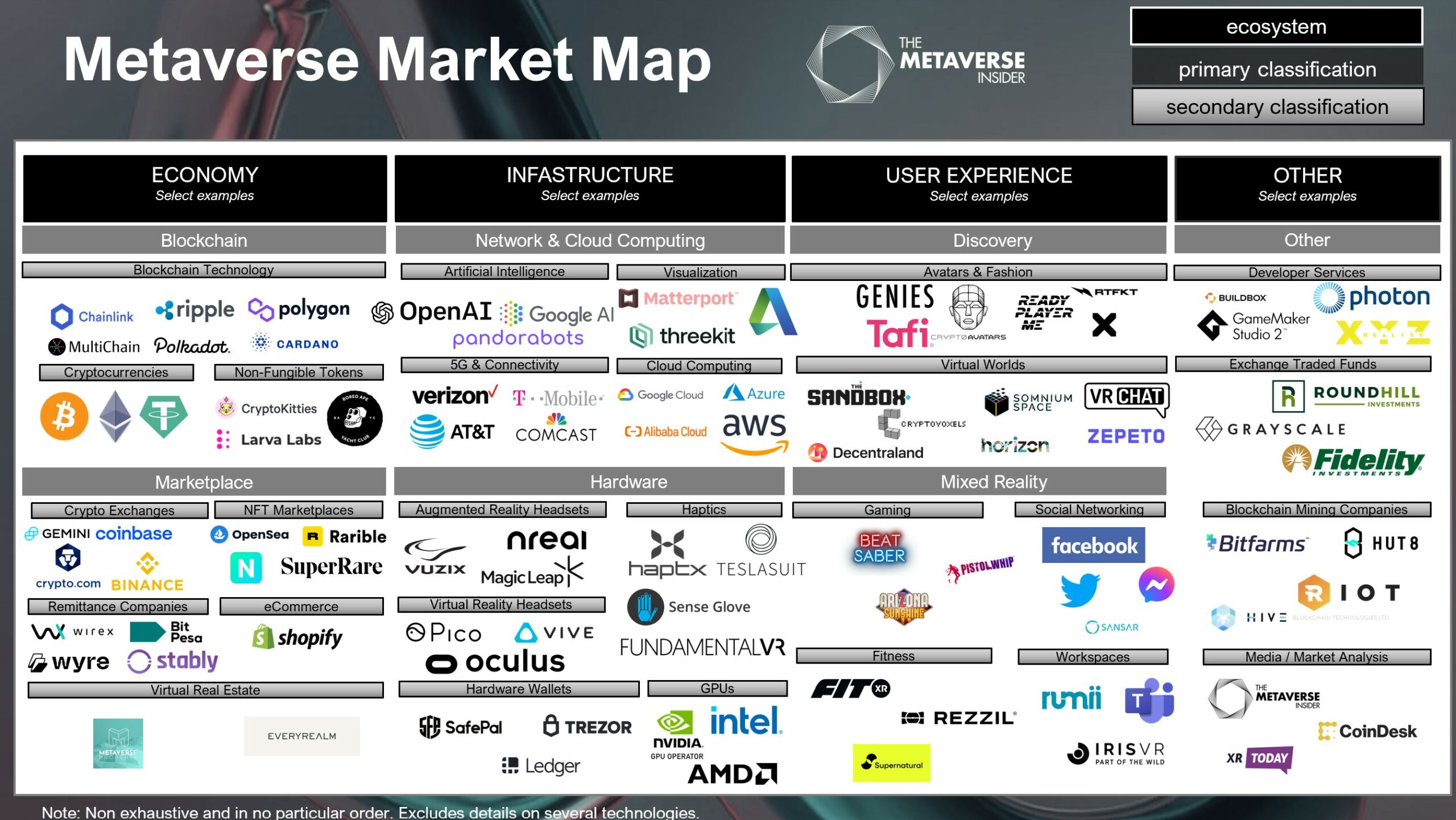Click here to view our Interactive Metaverse Market Map for a more comprehensive and holistic view of the Metaverse Ecosystem.
The Metaverse Ecosystem is a complex, rapidly emerging market which has yet to be comprehensively mapped. At The Digital Twin Insider, we have spent months studying the fast-evolving metaverse market. The result: The Metaverse Market Map

We decided that the best way to share this was through a detailed market map, underpinned by our proprietary classification system. Over the coming months we will be making this available in a more detailed online platform.
First let’s start with a case study.
Meta in the Metaverse
Widespread interest in the Metaverse really started to grow with Facebook’s annual event, Connect 2021, when the company officially changed its name to Meta. The name change was a massive statement of intent by CEO Mark Zuckerberg and his team. The acquisition of Oculus, the partnership with Ray-ban, and the investment in Virtual Reality development started to make sense to market analysts. Whilst headlines were bleating that Meta lost $10bn we saw this as a robust investment in future growth, underpinning the potential market opportunity that clearer heads were seeing.
To develop a market map of the metaverse, we first decided to look at the markets Meta is targeting.

Our analysis shows that the company has three main focus areas in the metaverse:
- Hardware: Meta offers Virtual Reality and Augmented Reality headsets.
- Metaverse Gateway: Once the user has a Meta’s Virtual Reality headset on, they get to explore Meta’s own Metaverse Gateway called Horizon Worlds.
- Developer Services: To improve their Metaverse Gateway, Horizon, and the VR applications offered through their headsets, Meta has hugely incentivized developers to create and enhance VR technology.
Additionally, Meta had previously attempted to launch its cryptocurrency called Diem. While this project was eventually cancelled, it is still very apparent that Meta understands the importance of blockchain technology and the built-in payment system in the future of the metaverse.
By looking at just one company, you can get a sense of the mix of hardware and software that will go into building the Metaverse value chain. However, Meta is only one player in a fast growing, increasingly complex market.
We decided to take a macro look into where the future of metaverse lies and which companies are helping shape this vision.
Metaverse Market Map
The metaverse market can be organized into three overarching themes.;
- Economy: Blockchain Technology and Marketplace
- Infrastructure: Hardware and Network
- User Experience: Discovery and Mixed Reality
Economy
Blockchain technology has given birth to a new type of economic system. This technology has given birth to cryptocurrencies and non-fungible tokens. Blockchain, the technology behind cryptocurrencies and non-fungible tokens, holds certain advantages over the current economic system. We live in a global village. Being able to use your digital assets and money anywhere in the world without worrying about the exchange rates and inflation in a particular region are just a few of the reasons investors are pouring in. Investors are also interested in the marketplace that makes the exchange of these assets in the new metaverse economy possible. Thus, we classified the economy into blockchain technology and the marketplace making it possible.
Blockchain Technology
With the rise of bitcoin and other cryptocurrencies, interest in decentralized finance has skyrocketed in the past few years. We have listed 20 metaverse companies which have benefited from an interest in Decentralized Finance and cryptocurrencies. Over the past few years, the growth of decentralization in the finance sector has accelerated. Features of Decentralized Finance, such as being permissionless, transparent, and tamper-proof, have attracted investors worldwide. Blockchain technology is the backbone of decentralized finance. Many blockchains are present in the market today. However, not all blockchains are built the same. They have distinct features which make them stand out to different types of businesses and projects. Most blockchain technologies can be divided into four primary categories, private, public, hybrid, and consortium. The following infographic describes these different types of blockchains.

These four types of blockchain technologies have distinct features suitable for different projects:
- Public Blockchains are permissionless and have no restrictions, thus making them completely decentralized. Public blockchains allow all nodes to have equal rights when accessing the blockchain, creating new blocks, and validating blocks of data. Traditionally, all blockchains were public, and thus, cryptocurrencies (which were the first widespread use case for blockchain technology) are public blockchains.
- Hybrid Blockchains are a combination of public and private blockchains. These blockchains feature a public permissionless system and a private permission-based system. A selected section of data goes public while the rest remains confidential. Hybrid blockchains are controlled by one organization. The public blockchain provides oversight by performing specific transaction validations. IBM Food Trust is a hybrid blockchain which connects participants across the food supply.
- Consortium Blockchains are permissioned blockchains. These blockchains are managed and governed by multiple organizations. Thus, various organizations can act as a node in this type of blockchain and exchange information. These blockchains are becoming increasingly popular with banks, governments, and organizations. An example of a consortium blockchain is Marco Polo.
- Private Blockchains are permissioned blockchains. Unlike consortium blockchains, private blockchains are governed by a single blockchain. Only selected members can be participants of the blockchain. The central authority controls permissions and accessibility in this blockchain. A notable example of private blockchains is MultiChain.
Cryptocurrencies and Non-Fungible Tokens are ostensibly the most popular use cases for blockchain technology. Many blockchains have their native tokens. The most popular is perhaps Ether on the Ethereum blockchain. However, other tokens, such as SOL on the Solana blockchain, have also gained popularity.
Non-Fungible Tokens are financial securities consisting of digital data stored on the blockchain. NFTs are a critical factor in enabling the metaverse universe as important decentralized metaverses such as Decentraland and The Sandbox use NFTs to sell land, buildings, and other unique items. While many NFTs in the market use the ERC-721 token on the Ethereum blockchain, many other blockchain technologies specialize in NFTs. One example of blockchain technology being built for NFTs is the FLOW blockchain. This technology has enabled many popular NFT projects by established sports leagues like La Liga, NFL, and NBA. We analyzed the growth of NFTs and the FLOW blockchain here.
Marketplace
Blockchain technology, along with NFTs and cryptocurrencies, is revolutionary and will undoubtedly impact the future of finance. However, this can only be achieved if these products can be made available to the customers and traded. Early adopters who purchased bitcoin often expressed how difficult it was to acquire cryptocurrency. It involved a lengthy and sometimes unreliable process of buying crypto and often led to arbitrages around the world. Sam Bankman-Fried, the founder of FTX, famously took advantage of this arbitrage opportunity earning one million USD a day by buying cryptocurrency in the US and selling it in Japan. In this video with Nas Daily, a popular content creator, Sam explains how he did it.
Cryptocurrency Exchanges have been essential to the mass adoption of crypto for the past two years. In January 2022, Finbold released a report stating that over 10 percent of the world which had access to the internet also owned some cryptocurrency. An adoption like this would be impossible without the mass adoption of cryptocurrency exchanges around the globe. Crypto.com is an excellent example of the success of cryptocurrency exchanges. The domain of crypto.com was acquired by one of the co-founders. The company decided to stick to the website name, and today the organization is fast becoming a household name. Crypto.com’s sponsorship of the iconic Staples Centre, home to some iconic sports teams such as the LA Lakers, LA Clippers, and LA Kings, made news worldwide. Moreover, FIFA has confirmed that the exchange will also be sponsoring the 2022 World Cup held in Qatar.
Like the cryptocurrency exchanges have accelerated the adoption of cryptocurrencies, NFT Marketplaces have made it easier for users to purchase and display their digital assets. 2021 was a massive year for NFTs, with collections like Bored Ape Yacht Club and CryptoPunk selling for hundreds of thousands (and sometimes millions) of dollars. Undoubtedly, the ease of purchasing these digital assets has been a massive factor in the mass adoption of NFTs. OpenSea is currently the most popular NFT marketplace. As of January 2022, OpenSea is valued at over 13 billion dollars in its latest funding round.
However, Marketplace in the Metaverse is not only limited to NFTs and cryptocurrencies. Many other companies are popping up in the industry to facilitate the growth of the metaverse. Remittance companies (a business that transfers money electronically for consumers to people and businesses in foreign countries) have made it much easier to transfer funds and have attracted the interest of venture capital funds. The eCommerce space is also a fast-evolving yet relatively untapped space in the metaverse. Meta has announced its version of Marketplace to facilitate eCommerce in its metaverse called Horizon. Existing eCommerce players like Shopify are also keen to expand into the metaverse industry by integrating Augmented Reality into their platform. Lastly, Virtual Real Estate is becoming increasingly valuable in metaverse gateways like Decentraland and Sandbox. Real estate can be bought, sold and rented. Many early buyers equate purchasing real estate in these metaverse gateways to purchasing property in Manhattan in the 1800s. While it remains to be seen if this will be true, virtual real estate agencies are entering the market. The success of these virtual real estate agencies is directly related to the adoption of the metaverse in the market, and thus, it remains to be seen how successful they will be.
Infrastructure
After exploring the economy that will power the metaverse, we decided to look into the infrastructure essential to the metaverse’s adoption. The infrastructure that powers the metaverse will determine the end users’ experience. Meta has committed a vast amount of capital and services to facilitate the development of its platforms. This is because metaverse gateways cannot be built without the proper hardware and network (such as AI, cloud computing, etc.). Thus, we have provided an analysis of the infrastructure that enables a great user experience.
Hardware
Virtual Reality Headsets are the portal to the Virtual Reality world. In 2014, long before Facebook changed its name to Meta, it acquired Oculus. At the time, it seemed like an odd acquisition for a social media company to make. However, eight years later, this acquisition has become the worlds’ best selling VR headset. Thus, helping Meta lead the race to bring metaverse into the mainstream. The VR headset space is an area which other tradition hardware providers like Playstation just haven’t been able to capitalize on yet. When one thinks about hardware for the metaverse, a VR headset is probably the first product that comes to mind. While Oculus leads the VR headset market, competition has undoubtedly arrived with HTC Vive and Pico products.
Augmented Reality Headsets are being developed as an essential tool for working professionals in the future. Many users may not realize the importance of Augmented Reality. While Virtual Reality headsets are undoubtedly an essential aspect in adopting the metaverse, augmented reality headsets are a much more complicated problem that will yield huge dividends to any developer who can get it right. Perhaps, the most well-known AR glasses were Google Glass. Despite a viral launch, the glasses could not gain mass adoption. While AR glasses are still primarily used in workspaces such as Microsoft Hololens, the end goal is still yet to be realized. Companies like Meta and Snapchat have settled for a more straightforward set of glasses that can take pictures and record audio.
Haptics is technology which will help bring a sense of touch and feel in the metaverse. For an engaging experience in the metaverse, haptics will play an integral part. There are a lot of startups that have started to experiment with bringing a sense of touch to help enhance immersion in virtual worlds. Some of these startups, like HaptX and Sense Glove, are developing gloves to help get a sense of touch. However, there are other startups like Teslasuit, which have developed complete bodysuits to ensure total immersion. Here is our article on sensory experiences in the metaverse.
GPUs and mining chips are essential to the mass adoption of the metaverse. Companies like NVIDIA that build graphic processing units (GPUs) for the gaming industry have expanded into the metaverse industry by providing services like Blender, which enable 3D animation. Their company’s Nvidia RTX GPU accelerates this technology. GPUs like the one by Nvidia are essential to adopting 3D technology.
Hardware Wallets are increasingly becoming a pivotal component of the blockchain ecosystem. According to many users, these wallets are far more secure as they give an extra layer of security against cyber attacks, malware, and phishing sites. As long as the users can keep their private keys safe, users can interact with their tokens anywhere. The hardware wallet itself does not store the users’ cryptocurrency (that lives on the blockchain), but the private key is the only way for users to access it. Ledger is currently the most popular hardware wallet company that allows users to store and protect their Bitcoin, Ethereum, and other ERC-20 tokens.
Network & Cloud Computing
Artificial Intelligence, 5G, and virtual reality are technologies that are all critical to ensure the adoption of metaverse is quick and seamless. The advancement of these technologies will be the backbone of most metaverse applications. Thus, it is necessary to investigate the companies that power the metaverse and the technology that will accelerate the growth of this new industry.
Artificial Intelligence is an important part of the metaverse as it will enable users to interact in freely in virtual reality. At Meta’s event titled “Inside the lab: Building for the metaverse and AI,” Zuckerberg stated that artificial intelligence could be the most foundational technology of our time. AI research is critical to the acceleration of the growth of the metaverse. Self-supervised learning can help perform several downstream tasks. Thus, tasks such as identifying problems such as hate speech and scams will be faster to ensure the metaverse runs smoothly. AppLovin is an example of an AI company leveraging machine learning and predictive algorithms to improve applications. Digital Twin Insider investigated a study which researches the importance of blockchain and artificial intelligence here.
Cloud Computing will be critical to the success of the metaverse industry, given the amount of storage and processing required to support a virtual reality universe. As 3D and VR technology improves, remote-based cloud computing seems like the only viable option which will be cost-effective for the companies to scale. The metaverse companies are a massive opportunity for existing cloud providers like Alibaba Cloud Services and Oracle Cloud. Other cloud providers such as Amazon Web Services, Microsoft Azure and Google Cloud Platform, are all keen on catering to the metaverse as well. Google Cloud has launched a Digital Assets team. Amazon Web Services has gone a step further, launching a metaverse type game to educate and train people on how to use their cloud computing services. On-Demand computation and storage using pay-as-you-go models may be an attractive option for many new virtual worlds. Public Cloud providers and private data centres are targeting the metaverse as a huge opportunity.
Visualization & Digital Twin means building out new 3D spaces and has become a fantastic opportunity for developers to be creative and imaginative in building their wildest fantasies in the virtual worlds. However, there is also a need to incorporate the real world into the VR space. Moreover, augmented reality is becoming a crucial part of the metaverse as well as users may not want to have 3D headsets on all the time. Companies like Matterport and Ef Eve have great visualizing of real-life spaces in augmented reality. A use case for this is ecommerce where users can feel how a product would look in their room using these visualization companies.
User Experience
Zuckerberg acknowledged development in 3D is significantly more complex than in 2D. Creating content and applications for VR poses a significant challenge. We have divided User Experience into two classifications: Discovery and Mixed Reality. Discovery includes categories representing the users, interface and most importantly, the metaverses themselves. Mixed reality is the use case of these metaverse spaces.
Discovery
Technology that powers the user interface has not been perfected in VR. It has been imperative to build the technology that helps users interact in virtual worlds. These can be in the form of virtual concerts or other events that are set up to help users interact. Multi Image Group is a perfect example of an organization working to ensure users can interact and meet in virtual reality. The company allows users to set up virtual concerts and other digital exhibitions.
Avatars are a user’s representation in the metaverse. There are many startups which are facilitating users to be set up their cross-platform avatars. Recently, startups related to avatars and fashion have attracted enormous interest from investors. Genies, an avatar company, recently raised $ 150 million at over a billion-dollar valuation.
Fashion in the metaverse have also become a talking point. Recently, a successful fashion show in Decentraland was a massive statement of intent. Nike acquired a startup called RTFKT to launch its digital collectibles in the metaverse. The Digital Twin Insider had the opportunity to chat with the head of Decentraland Fashion Week, Giovanna Graziosi Casmiro in Lisbon.
While avatars, digital collectibles, and immersion start ups are great for the metaverse, The Metaverse Gateways (Virtual Worlds) themselves are the most important for the success of this industry. There are many metaverse gateways present for users to choose from. Meta’s gateway, called Horizon, is extremely popular as the adoption of Oculus VR headsets has taken off. However, decentralized metaverse gateways have made headlines as well. Decentraland and The Sandbox are currently the two most popular decentralized metaverse gateways. These metaverses have virtual currencies and allow users to buy, sell, and rent a property. We had an opportunity to chat with The Sandbox COO, Sebastien Borget in Lisbon where he laid out his vision for the metaverse and The Sandbox here.
This infographic has laid out the differences between decentralized and centralized metaverses.

Mixed Reality
Next, we have tried to lay out the four most popular virtual reality use cases.
Gaming is perhaps the most obvious target market for VR developers. Many popular game developers such as Ubisoft and Epic Games have anticipated the adoption of collaborative games. While many multiplayer games had unique skins and other collectibles, these games are starting to incorporate additional features of metaverse gateways now. Fortnite’s Travis Scott concert acknowledged the impact of the metaverse industry.
Fitness is also something that has attracted many users to virtual reality. VR headsets like Oculus have a plethora of game-like fitness applications which have garnered praise from the fitness industry. The Thrill of the Fight is one of the most popular fitness game in virtual reality, getting great reviews from individuals from combat sports such as Dana White and Forrest Griffin.
Social Networking has started to evolve recently, with Twitter embracing NFTs and Facebook changing its name to Meta. With two of the most prominent players in this industry making drastic changes like this, it is easy to see that social media will transform with the growth of the metaverse. The metaverse industry, may be considered a new way of social networking. Virtual Reality is becoming a new way of interacting with our peers. Apart from the traditional social networking applications, concerts, 3D gaming, and even decentralized metaverse gateways like Decentraland have become a new way to network.
Here we have investigated how social networking and gaming is getting incorporated into decentralized metaverses:

Workspaces round the world has already changed with the covid-19 pandemic. However, with the rise of metaverse technology, office jobs will continue to lessen. Various VR meeting room applications such as Spatial and Softspace have allowed workers to collaborate in virtual reality. Meta has launched its workspace called Horizon Workspace. Unlike Horizon Worlds, Meta’s metaverse gateway, Horizon Workspace will not require users to log in through their Facebook accounts. Users will be able to log in using their work accounts and collaborate with a professional and most likely a lifelike avatar collaborate with their team members.
See also: What is Metaverse? Guide into the Future of Digital Reality
Other
Having classified the companies in the metaverse space, we recognize that organizing these companies into a market map is a challenging task – not all organizations naturally fit into just one category and classifications are open for debate. For example, hardware wallets have been classified as hardware. However, hardware wallets can also be classified in the marketplace category. There are many such examples of judgement calls that we have made to categorize companies. However, we also have a list of companies that do not fit in any specific category. Most categories are usually services that support the metaverse but might not be directly involved.
Developer Services
We have come across many developers who offer services commonly used by companies looking to build in the metaverse space. These development companies fit into three different classifications. Developer Services in our market map have thus been classified into companies that serve the Marketplace, cloud, and discovery. Development Services for the Marketplace are companies that help companies serve the economy within the metaverse. Boston Protocol is an excellent example of a developer service for the Marketplace which enables the seamless exchange of digital assets.
Exchange Traded Funds
It is fascinating to see how metaverses like The Sandbox and Decentraland have self-sustaining economies with their in-built currencies that can buy and sell virtual properties and other in-game items. However, many of the population still does not have access to the metaverse or have not invested in cryptocurrencies or NFTs. Exchange-traded funds that have exposure to the metaverse are becoming increasingly popular in the financial markets. We have listed three ETFs that we have been following in this article.
Blockchain Mining Companies
The cryptocurrency industry is still developing, with many speculating where the market is heading in the next 5 to 10 years. We have seen a drastic increase in people entering the cryptocurrency market in the last two years. These cryptocurrencies use blockchain technology to generate and maintain a record of the transactions. Thus, there is a need for cryptocurrency mining companies to generate the computational power to solve complex problems to validate transactions on the blockchain and generate new cryptocurrency coins. There have been mining companies that have been around for almost a decade and have gone public investing in companies like Bitfarms Ltd. and Hut 8 Mining Corp. allows investors to be a part of the metaverse economy too.
Media/Market Analyst
In 2021, we watched Facebook change its name to Meta, Bitcoin cross 65,000 dollars, and a piece of land sell for 4.3 million dollars in The Sandbox. Our interest in the metaverse industry had spiked like many others in this space. Thus, in December 2021, the team at Digital Twin Insider assembled to provide coverage of the emerging technology in the metaverse and highlight the market leaders. Over the past few months, we have had the chance to interact with major players in this game like Veefriends and The Sandbox. Moreover, we help businesses in this space with intelligence and market analysis.
If you would like to contact us, please reach out to us on [email protected]
Tap here to subscribe the newsletter
If you found this article to be informative, you can explore more current Digital Twin news here













